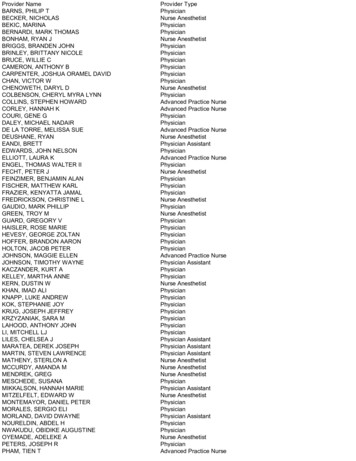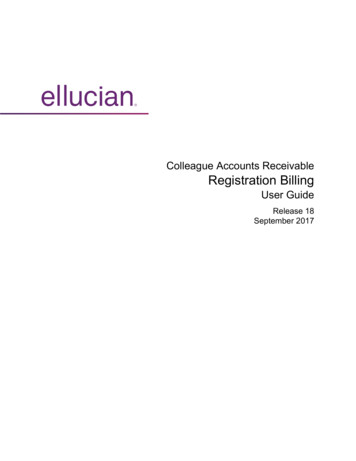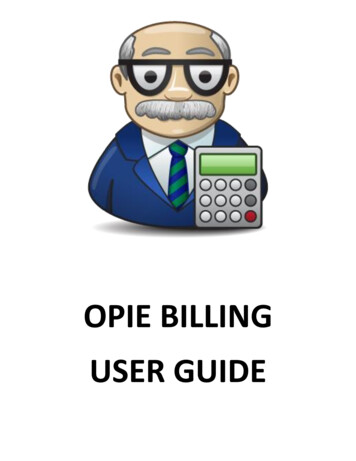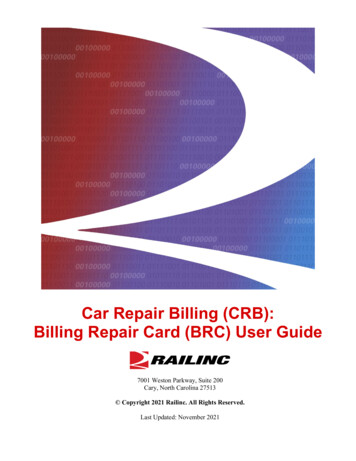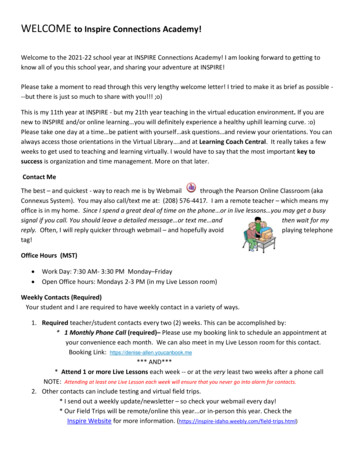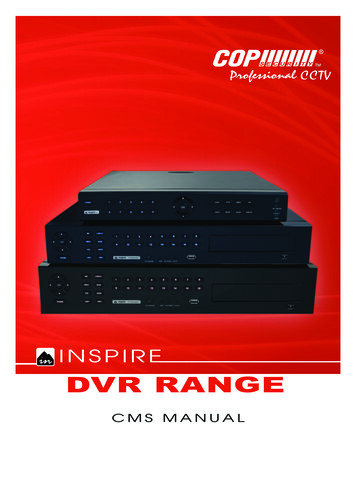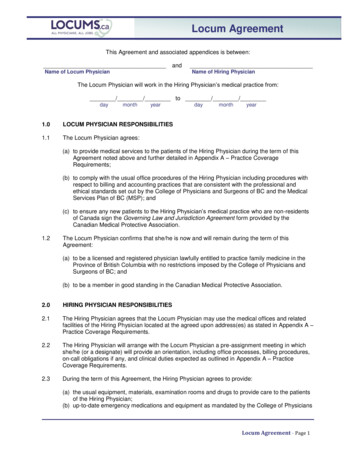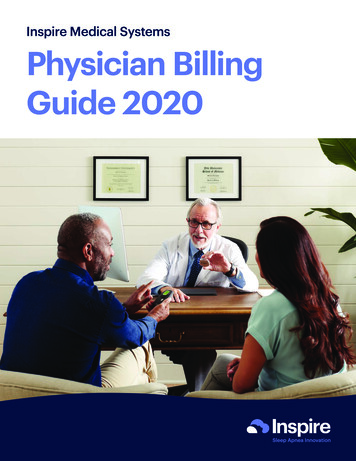
Transcription
Inspire Medical SystemsPhysician BillingGuide 2020
Inspire Medical Systems Physician Billing GuideThis Physician Billing Guide was developed to help providers correctly bill for Inspire Upper AirwayStimulation (UAS) therapy. This Guide provides background information on payer coverage forimplantable devices as well as proper coding and billing for Medicare and private payers. Thecontents are intended to augment the physician’s current awareness of coding and coverage forimplantable devices.Inspire Medical Systems has made every effort to ensure that the information in this Guide issuitable, accurate, and appropriate to describe and code the services provided in the care andmanagement of patients undergoing a UAS implant procedure for obstructive sleep apnea. Thesample codes displayed should be used to facilitate appropriate coding and should not be construedas recommendations or guidelines in establishing policy, physician services or procedures, physicianpractice, or standards of care.For questions regarding reimbursement, please call the Inspire Reimbursement Hotline at1-833-897-0939 or email questions to reimbursement@inspiresleep.com.Inspire Medical Systems, Inc.1
Inspire Medical Systems Physician Billing GuideDevice and Procedure Description. 3 Device DISE Procedure Implant Procedure Analysis & Programming ProceduresCoverage. 4 FDA Approval Medicare Coverage Private Payer Coverage Reimbursement DenialsUpper Airway Examination Coding . 5 Diagnosis Codes CPT Procedure CodesImplant Coding . 6 Diagnosis Codes CPT Procedure CodesRevision, Removal and Replacement Procedure Coding. 8 CPT Procedure CodesAnalysis and Programming Coding . 8 Diagnosis Codes CPT Procedure CodesBilling Requirements. 10Sample Claims.11 - 13Disclaimers and Appendices.14 Information on the Medicare Appeal ProcessInspire Medical Systems, Inc.2
Device and Procedure DescriptionDeviceInspire Upper Airway Stimulation (UAS) therapy is a neurostimulation system for the treatment ofmoderate to severe obstructive sleep apnea. The system detects breathing patterns while the patientis sleeping and stimulates the hypoglossal nerve (cranial nerve XII) to move the tongue and soft palatefrom obstructing the airway.The system consists of three implantable components: Generator – Like all neurostimulators, the generator provides the electrical stimulation pulse. Stimulation Lead – The stimulation lead delivers the stimulation pulse to the hypoglossal nerve. reathing Sensor Lead – The breathing sensor lead detects breathing patterns and relays this Binformation to the generator.Upper Airway Examination CodingDISE (Drug Induced Sleep Endoscopy) is a required diagnostic procedure for evaluating palatialcollapse for Hypoglossal Nerve Stimulation. During the procedure, artificial sleep is induced bymidazolam and/or propofol, and the pharyngeal collapse patterns are visualized using a flexiblefiberoptic nasopharyngoscope. The level (palate, oropharynx, tongue base, hypopharynx/epiglottis),the direction (anteroposterior, concentric, lateral), and the degree of collapse (none, partial, orcomplete) are examined. Occasionally, a physician may choose to examine the upper airway while thepatient is awake using local anesthesia.Implant ProcedureThe generator is placed in a subcutaneous pocket created via blunt dissection, typically in theupper chest. Following surgical exposure, the stimulation lead is placed in the upper neck with thecuff wrapped around the hypoglossal nerve. It is tunneled subcutaneously to the upper chest andconnected to the generator. The breathing sensor lead is placed via incision into the plane betweenthe external and internal intercostal muscles in the lower chest. It is tunneled subcutaneously andconnected to the generator. The system is programmed and periodically interrogated andre-programmed to meet the patient’s needs.Analysis and Programming ProceduresDuring electronic analysis of the implanted neurostimulator pulse generator/transmitter, settingssuch as electrode configuration, amplitude, pulse width, rate, start delay, burst, patient selectableparameters, responsive neurostimulation, detection algorithms, closed loop parameters, and passiveparameters are analyzed.Programming includes adjusting parameters (eg, current, frequency, pulse width, train duration,magnet mode, or sensing), based on respiratory, obstructive apneas and/or swallowing difficulties. Thephysician or other qualified health care professional conducts multiple stimulation trials, adjusting theparameters until optimal therapeutic stimulation are achieved.Inspire Medical Systems, Inc.3
CoverageFDA ApprovalInspire UAS therapy received PMA approval from the FDA on April 30, 2014.Medicare CoverageMedicare and other payers determine whether to cover the procedure or technology as a healthbenefit based on the published literature as well as business considerations. The first requirement isFDA approval.An FDA-regulated product must receive FDA approval or clearance (unless exempt from the FDApremarket review process) for at least one indication to be eligible for consideration of Medicarecoverage (except in specific circumstances). However, FDA approval or clearance alone does notentitle that technology to Medicare coverage.8.7.2013, Federal Register, Vol. 78, No. 152, page 48165Although not required, Medicare may develop national or local coverage policies specific to theprocedure or technology. These policies may extend coverage for the procedure or technologyfor certain diagnoses or in specific scenarios, or they may identify the procedure or technology asgenerally non-covered. At this time, there is no Medicare national coverage policy on the UAS device,however some Medicare Administrative Contractors (MACs) have released policies and guidelines forUAS on the local or regional level.It is the responsibility of the provider to be aware of existing Medicare coverage policies beforeproviding the service to Medicare beneficiaries.Traditional Medicare does not require or allow prior authorization or prior approval for procedures. Tolimit the risk of Medicare non-coverage, physicians should contact their local MAC’s Medical Director inadvance. Physicians can also contact Inspire Medical Systems for support in this process.Note: Medicare Advantage plans are managed by commercial payers. Those payers may require priorauthorization for Medicare Advantage patients.Private Payer CoveragePrivate payers also require FDA approval. Once approved, coverage is determined according to theframework of each patient’s specific plan, rather than on a geographic basis like Medicare.Unlike traditional Medicare, private payers often require prior authorization for an elective proceduresuch as UAS implantation. Before scheduling a patient’s UAS procedure, the physician can contactInspire Medical Systems’ Prior Authorization program to determine the availability of coverage.Proceeding without a required prior authorization typically results in denial and non-payment.Reimbursement DenialsPrivate payers sometime deny prior authorizations or a submitted claim. Medicare may also deny asubmitted claim. See Appendix A for information on the Medicare appeal process. For private payerdenials, physicians can contact Inspire Medical Systems for support. When doing so, it is helpful toprovide the payer’s denial letter or the Explanation of Benefits outlining the reasons for denial.Inspire Medical Systems, Inc.4
Upper Airway Examination CodingDiagnosis CodesDiagnosis coding for endoscopic evaluation of the upper airway may involve the following code:ICD-10-CM Diagnosis CodeCode DescriptionG47.33Obstructive sleep apnea (adult), (pediatric)This code includes obstructive sleep apnea hypopnea.Procedure CodesPre-operative anatomical assessment of the upper airway is required for all Inspire patients. Theprocedure most performed is a Drug Induced Sleep Endoscopy (DISE), which is an evaluation of theupper airway after pharmacologic induction of unconscious sedation. Occasionally a physician maychoose to examine the upper airway while the patient is awake using local anesthesia. The followingcodes can be used for either asleep or awake endoscopic examinations.CPT 1ProcedureCodeCode DescriptionRVU*Service92511Nasopharyngoscopy with endoscope (separate procedure)NF 3.18Fac 1.08Asleep or awake,nasal approach92502Otolaryngologic examination under general anesthesia**NF - NAFac 2.69Asleep onlyLaryngoscopy, flexible fiberoptic; diagnosticNF 3.49Fac 1.90Asleep or awake,nasal or oralapproach31575*2020 RVUs as published in 2020 Physician Fee Schedule Final RuleNF Non-Facility RVU ValueFac Facility RVU ValueNote: Facility RVU values reflect physician time and work for services performed in a facility (i.e. hospital or ASC) setting. Non-facility RVUs reflect the physician time and work and practiceexpense to perform the service is a freestanding (i.e. non-hospital-based) clinic** Cannot be reported with 31575 (Correct Coding Initiative (CCI) edits) If CPT 31575 is billed with 92511, most extensive procedure edit applies.1CPT Copyright 2017 American Medical Association. All rights reserved. CPT is a registered trademark of the American Medical Association. Applicable FARS/DFARS Restrictions Apply toGovernment Use. Fee schedules, relative value units, conversion factors and/or related components are not assigned by the AMA, are not part of CPT, and the AMA is not recommendingtheir use. The AMA does not directly or indirectly practice medicine or dispense medical services. The AMA assumes no liability for data contained or not contained herein.Inspire Medical Systems, Inc.5
Implant CodingImplant Diagnosis CodesInspire Upper Airway Stimulation (UAS) therapy is used to treat a subset of patients with moderate tosevere Obstructive Sleep Apnea (OSA) (apnea-hypopnea index [AHI] of greater than or equal to 15 andless than or equal to 65). Diagnosis coding for UAS implantation may involve the following code:ICD-10-CM Diagnosis CodeCode DescriptionG47.33Obstructive sleep apnea (adult), (pediatric)This code includes obstructive sleep apnea hypopnea.For Medicare there is a dual diagnosis requirement. Coverage for hypoglossal nerve stimulationprocedures on patients who meet coverage criteria must include both a primary ICD-10-CM diagnosiscode indicating the reason for the procedure and a secondary ICD-10-CM diagnosis code indicatingthe Body Mass Index (BMI) is less than 35 kg/m2 as set forth in the LCD Covered Indications. Report aprimary diagnosis code of OSA and a secondary diagnosis code from Group below:ICD-10-CM Diagnosis CodeCode DescriptionZ68.1Body mass index (BMI) 19.9 or less, adultZ68.20Body mass index (BMI) 20.0-20.9, adultZ68.21Body mass index (BMI) 21.0-21.9, adultZ68.22Body mass index (BMI) 22.0-22.9, adultZ68.23Body mass index (BMI) 23.0-23.9, adultZ68.24Body mass index (BMI) 24.0-24.9, adultZ68.25Body mass index (BMI) 25.0-25.9, adultZ68.26Body mass index (BMI) 26.0-26.9, adultZ68.27Body mass index (BMI) 27.0-27.9, adultZ68.28Body mass index (BMI) 28.0-28.9, adultZ68.29Body mass index (BMI) 29.0-29.9, adultZ68.30Body mass index (BMI) 30.0-30.9, adultZ68.31Body mass index (BMI) 31.0-31.9, adultZ68.32Body mass index (BMI) 32.0-32.9, adultZ68.33Body mass index (BMI) 33.0-33.9, adultZ68.34Body mass index (BMI) 34.0-34.9, adultInspire Medical Systems, Inc.6
Implant Procedure CodesThe initial UAS implant procedure may involve the following codes:CPT ProcedureCodeCode DescriptionFacilityRVU*Component64568Incision for implantation of cranial nerve (eg, vagus nerve)neurostimulator electrode array and pulse generator18.06Generator andstimulation lead 0466TInsertion of chest wall respiratory sensor electrode or electrodearray, including connection to a pulse generator (List separatelyin addition to code for primary procedure)(Use 0466T in conjunction with 64568)0.00Breathing sensorleadRegular Category I CPT code 64568 is assigned for placement of the generator and the stimulation lead.Because UAS stimulates the hypoglossal nerve, the system qualifies as a cranial nerve neurostimulator.The breathing sensor lead is a distinct component and is represented by Category III CPT code 0466T. As indicated by the symbol, this is an add-on code and cannot be assigned by itself. Code 0466T for the breathing sensor lead must always be assigned together with code 64568 for thegenerator and stimulation lead.Revision, Removal and ReplacementProcedure CodingIn addition to implantation, the UAS device may require revision, removal, or replacement at some timeduring its life cycle. These procedures may involve the following codes:CPT ProcedureCodeCode DescriptionFacilityRVU*Component61886Insertion or replacement of cranial neurostimulator pulsegenerator or receiver, direct or inductive coupling; withconnection to 2 or more electrode arrays24.69Generator61888Revision or removal of cranial neurostimulator pulsegenerator or receiver11.39Generator64569Revision or replacement of cranial nerve (eg, vagus nerve)neurostimulator electrode array, including connection toexisting pulse generator21.90Stimulation lead64570Removal of cranial nerve neurostimulator electrode arrayand pulse generator21.08Generator andStimulation lead64585Revision or removal of peripheral neurostimulator electrode array4.14Stimulation lead0467TRevision or replacement of chest wall respiratory sensor electrodeor electrode array, including connection to existing pulse generatorNABreathingsensor leadInspire Medical Systems, Inc.7
Removal of chest wall respiratory sensor electrodeor electrode array0468TBreathingsensor leadNARegular Category I CPT codes for cranial neurostimulators are used for revision, removal, andreplacement procedures involving the generator and/or the stimulation lead. Category III codes are usedfor revision, replacement, and removal of only the breathing sensor lead.Analysis and Programming CodingAnalysis and Programming Diagnosis CodingDiagnosis coding for routine UAS analysis and programming may involve the following codes:ICD-10-CM Diagnosis CodeCode DescriptionG47.33Obstructive sleep apnea (adult), (pediatric)Z45.42Encounter for adjustment and management of neuropacemaker (brain)(peripheral nerve) (spinal cord)Polysomnogram Procedure CodingThe UAS device requires programming during an in-lab sleep study. The appropriate polysomnogramcode to be used in conjunction with device programming is:CPT ProcedureCodeCode DescriptionRVU*Service95810Polysomnography; age 6 years or older, sleep staging with4 or more additional parameters of sleep, attended by atechnologistNF 17.21Fac 3.45Polysomnogramperformed duringprogrammingInspire Medical Systems, Inc.8
Analysis and Programming Procedure CodingCPT ProcedureCodeCode Description95970Electronic analysis of implanted neurostimulator pulsegenerator/transmitter (eg, contact group(s), interleaving,amplitude, pulse width, frequency (Hz), on/off cycling, burst,magnet mode, dose lockout, patient selectable parameters,responsive neurostimulation, detection algorithms, closed loopparameters, and passive parameters) by physician or otherqualified health care professional; with brain, cranial nerve,spinal cord, peripheral nerve, or sacral nerve neurostimulatorpulse generator/transmitter, without programming95976Electronic analysis of implanted neurostimulator pulsegenerator/ transmitter (eg, contact group(s), interleaving,amplitude, pulse width, frequency (Hz), on/off cycling, burst,magnet mode, dose lockout, patient selectable parameters,responsive neurostimulation, detection algorithms, closed loopparameters, and passive parameters) by physician or otherqualified health care professional; with simple cranial nerveneurostimulator pulse generator/transmitter programming byphysician or other qualified health care professional95977Electronic analysis of implanted neurostimulator pulse generator/transmitter (eg, contact group(s), interleaving, amplitude,pulse width, frequency (Hz), on/off cycling, burst, magnetmode, dose lockout, patient selectable parameters, responsiveneurostimulation, detection algorithms, closed loop parameters,and passive parameters) by physician or other qualified healthcare professional; with complex cranial nerve neurostimulatorpulse generator/transmitter programming by physician or otherqualified health care professionalRVU*ServiceNF .55Fac .54Device analysis only,without programming,subsequent visitsonly (not at thetime of generatorimplantation)NF 1.18Fac 1.16Device analysis andsimple programming(not at the timeof generatorimplantation)NF 1.54Fac 1.52Device analysis andcomplex programming(not at the timeof generatorimplantation)Code 95970 is not assigned for device analysis when performed at the time of generator implantation.CPT manual instructions state that code 95970 describes only “subsequent” electronic analysis of “apreviously implanted” generator.Code 95976 is defined for simple programming and code 95977 is defined for complex programming.Simple programming refers to changing three or fewer parameters. Complex programming refers tochanging four or more parameters.Whenever programming is performed, it is essential that physicians individually name and documentthe specific parameters changed for coding purposes.Inspire Medical Systems, Inc.9
Billing RequirementsMedicare has specific instructions for submitting physician claims. Prior authorization is a good time tocheck for the payer’s billing requirements specific to implantable devices.Physician Billing on the CMS-1500Claim Form ItemValuesNotesItem 21ADiagnosis (primary)Display the primary ICD-10-CM diagnosis codes(see page 6).Item 21 B-LDiagnosis (BMI/other)Display ICD-10-CM diagnosis codes for the patient’ssecondary diagnoses.Item 23Prior Authorization NumberDisplay the payer’s prior authorization number ifobtained.Item 24DProcedures, Services, or SuppliesDisplay the CPT code for each procedure orservice rendered, with one CPT code in eachline. Include modifiers as needed, eg, 51, Multipleprocedures.Item 24EDiagnosis PointerRelate the services in 24 D to the diagnosis codesin 21 A-LInspire Medical Systems, Inc.10
DISE CMS-1500 Billing ExampleInspire Medical Systems, Inc.11
Physician Surgery CMS-1500 Billing Example* BMI Diagnosis code is required on Medicare claimsPlease ensure the Prior Authorization number is included on every claim submitted to commercialinsurance providers.Inspire Medical Systems, Inc.12
Programming CMS-1500 Billing ExampleInspire Medical Systems, Inc.13
DisclaimersInspire Medical Systems has authorized the completion of this Guide for the benefit of physiciansimplanting Inspire UAS therapy. Readers of this Guide are advised that the contents of this publicationare to be used as guidelines and are not to be construed as policies of Inspire Medical Systems.Inspire Medical Systems specifically disclaims liability or responsibility for the results or consequencesof any actions taken in reliance on the statements, opinions, or suggestions in this Guide.Inspire Medical Systems makes no representations or warranties with respect to the contents of theGuide and disclaims any implied guarantee or warranty of fitness for any particular purpose. InspireMedical Systems will not be liable to any individual or entity for any losses or damages that may beoccasioned by the use of this Guide.Appendix A: Medicare Appeal ProcessMedicare Claims are typically processed within 30 days of submission I f denied – The physician must file a request for redetermination within 120 days from the date ofreceipt of the Remittance Advice. o receive a Physician Appeals Packet and/or with any questions you may have, please contact the TInspire Reimbursement Hotline at 833-897-0939 or reimbursement@inspiresleep.com. templated Redetermination appeal is included in the packet for claims. Please contact the AInspire Reimbursement Hotline at 833-897-0939 or reimbursement@inspiresleep.com for a copy. edicare requires a signature on each appeal. Please sign the appeal letter and the Mredetermination form and send to the address provided with: Copy of the denial P atient pre-op notes: polysomnography (PSG), drug induced sleep endoscopy (DISE) andsurgical consult Copy of completed patient selection checklist Op-notes Clinical articles and coding information included in the packetMACs generally issue a decision within 60 days of receipt of the request for redetermination. I f denied – The physician must file a request for reconsideration within 180 days of receipt of thedecision. gain, a templated reconsideration appeal is included in the packet for claims. A M edicare requires a signature on each appeal – please sign the appeal letter and reconsiderationform and send to the address provided with: Copy of the denial Patient pre-op notes (PSG, DISE and surgical consult) Copy of completed patient selection checklist Op-notesInspire Medical Systems, Inc.14
Clinical articles and coding information included in the packet enerally, a QIC sends a decision to all parties within 60 days of receipt of the request for GreconsiderationFor questions regarding reimbursement, please call the Inspire Reimbursement Hotline at1-833-897-0939 or email questions to reimbursement@inspiresleep.com. Inspire Medical Systems, Inc. 2020. All Rights Reserved. 800-221-001, Rev D.
Inspire Medical Systems Physician Billing Guide. This Physician Billing Guide was developed to help providers correctly bill for Inspire Upper Airway Stimulation (UAS) therapy. This Guide provides background information on payer coverage for . implantable devices as well as proper coding and billing for Medicare and private payers. The


